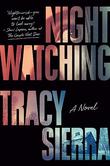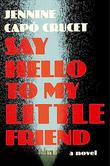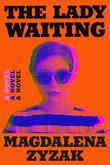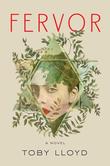
by Lauren Groff ‧ RELEASE DATE: June 5, 2018
A literary tour de force of precariousness set in a blistering place, a state shaped like a gun.
Awards & Accolades
Our Verdict

GET IT
Kirkus Reviews'
Best Books Of 2018
Kirkus Prize
finalist
National Book Award Finalist
In 11 electric short stories, the gifted Groff (Fates and Furies, 2015, etc.) unpacks the “dread and heat” of her home state.
In her first fiction since President Barack Obama named Fates and Furies his favorite book of the year, Groff collects her singing, stinging stories of foreboding and strangeness in the Sunshine State. Groff lives in Gainesville with a husband and two sons, and four of these tales are told from the perspectives of unmoored married mothers of young ones. The first, “Ghosts and Empties,” which appeared in the New Yorker, begins with the line, “I have somehow become a woman who yells,” a disposition the narrator tries to quell by walking at all hours as “the neighbors’ lives reveal themselves, the lit windows domestic aquariums.” Groff fans will recognize the descriptive zest instantly. The same quasi-hapless mother seems to narrate “The Midnight Zone,” in which she imperils the lives of her boys by falling off a stool and hitting her head while alone with them at a remote cabin, “where one thing [she] liked was how the screens at night pulsed with the tender bellies of lizards.” Ditto for the lonely oddballs telling “Flower Hunters” and “Yport,” the longest and last story, in which the reckless mother is often coated in alcohol. These are raw, danger-riddled, linguistically potent pieces. They unsettle their readers at every pass. In the dreamy, terrific “Dogs Go Wolf,” two little girls are abandoned on an island, their starvation lyrical: “The older sister’s body was made of air. She was a balloon, skidding over the ground”; their rescue is akin to a fairy tale. Equally mesmerizing is “Above and Below,” in which the graduate student narrator sinks away and dissipates into vivid, exacting homelessness. Even the few stories that dribble off rather than end, such as “For the God of Love, For the Love of God,” have passages of surpassing beauty. And Groff gets the humid, pervasive white racism that isn’t her point but curdles through plenty of her characters.
A literary tour de force of precariousness set in a blistering place, a state shaped like a gun.Pub Date: June 5, 2018
ISBN: 978-1-59463-451-2
Page Count: 288
Publisher: Riverhead
Review Posted Online: March 23, 2018
Kirkus Reviews Issue: April 15, 2018
Share your opinion of this book
More by Lauren Groff
BOOK REVIEW
by Lauren Groff
BOOK REVIEW
by Lauren Groff
BOOK REVIEW
by Nancy Hale edited by Lauren Groff
More About This Book
SEEN & HEARD

by Claire Lombardo ‧ RELEASE DATE: June 25, 2019
Characters flip between bottomless self-regard and pitiless self-loathing while, as late as the second-to-last chapter, yet...
Four Chicago sisters anchor a sharp, sly family story of feminine guile and guilt.
Newcomer Lombardo brews all seven deadly sins into a fun and brimming tale of an unapologetically bougie couple and their unruly daughters. In the opening scene, Liza Sorenson, daughter No. 3, flirts with a groomsman at her sister’s wedding. “There’s four of you?” he asked. “What’s that like?” Her retort: “It’s a vast hormonal hellscape. A marathon of instability and hair products.” Thus begins a story bristling with a particular kind of female intel. When Wendy, the oldest, sets her sights on a mate, she “made sure she left her mark throughout his house—soy milk in the fridge, box of tampons under the sink, surreptitious spritzes of her Bulgari musk on the sheets.” Turbulent Wendy is the novel’s best character, exuding a delectable bratty-ness. The parents—Marilyn, all pluck and busy optimism, and David, a genial family doctor—strike their offspring as impossibly happy. Lombardo levels this vision by interspersing chapters of the Sorenson parents’ early lean times with chapters about their daughters’ wobbly forays into adulthood. The central story unfurls over a single event-choked year, begun by Wendy, who unlatches a closed adoption and springs on her family the boy her stuffy married sister, Violet, gave away 15 years earlier. (The sisters improbably kept David and Marilyn clueless with a phony study-abroad scheme.) Into this churn, Lombardo adds cancer, infidelity, a heart attack, another unplanned pregnancy, a stillbirth, and an office crush for David. Meanwhile, youngest daughter Grace perpetrates a whopper, and “every day the lie was growing like mold, furring her judgment.” The writing here is silky, if occasionally overwrought. Still, the deft touches—a neighborhood fundraiser for a Little Free Library, a Twilight character as erotic touchstone—delight. The class calibrations are divine even as the utter apolitical whiteness of the Sorenson world becomes hard to fathom.
Characters flip between bottomless self-regard and pitiless self-loathing while, as late as the second-to-last chapter, yet another pleasurable tendril of sisterly malice uncurls.Pub Date: June 25, 2019
ISBN: 978-0-385-54425-2
Page Count: 544
Publisher: Doubleday
Review Posted Online: March 3, 2019
Kirkus Reviews Issue: March 15, 2019
Share your opinion of this book
More About This Book
SEEN & HEARD

by Mark Z. Danielewski ‧ RELEASE DATE: March 6, 2000
The story's very ambiguity steadily feeds its mysteriousness and power, and Danielewski's mastery of postmodernist and...
An amazingly intricate and ambitious first novel - ten years in the making - that puts an engrossing new spin on the traditional haunted-house tale.
Texts within texts, preceded by intriguing introductory material and followed by 150 pages of appendices and related "documents" and photographs, tell the story of a mysterious old house in a Virginia suburb inhabited by esteemed photographer-filmmaker Will Navidson, his companion Karen Green (an ex-fashion model), and their young children Daisy and Chad. The record of their experiences therein is preserved in Will's film The Davidson Record - which is the subject of an unpublished manuscript left behind by a (possibly insane) old man, Frank Zampano - which falls into the possession of Johnny Truant, a drifter who has survived an abusive childhood and the perverse possessiveness of his mad mother (who is institutionalized). As Johnny reads Zampano's manuscript, he adds his own (autobiographical) annotations to the scholarly ones that already adorn and clutter the text (a trick perhaps influenced by David Foster Wallace's Infinite Jest) - and begins experiencing panic attacks and episodes of disorientation that echo with ominous precision the content of Davidson's film (their house's interior proves, "impossibly," to be larger than its exterior; previously unnoticed doors and corridors extend inward inexplicably, and swallow up or traumatize all who dare to "explore" their recesses). Danielewski skillfully manipulates the reader's expectations and fears, employing ingeniously skewed typography, and throwing out hints that the house's apparent malevolence may be related to the history of the Jamestown colony, or to Davidson's Pulitzer Prize-winning photograph of a dying Vietnamese child stalked by a waiting vulture. Or, as "some critics [have suggested,] the house's mutations reflect the psychology of anyone who enters it."
The story's very ambiguity steadily feeds its mysteriousness and power, and Danielewski's mastery of postmodernist and cinema-derived rhetoric up the ante continuously, and stunningly. One of the most impressive excursions into the supernatural in many a year.Pub Date: March 6, 2000
ISBN: 0-375-70376-4
Page Count: 704
Publisher: Pantheon
Review Posted Online: May 19, 2010
Kirkus Reviews Issue: Feb. 1, 2000
Share your opinion of this book
More by Mark Z. Danielewski
BOOK REVIEW
BOOK REVIEW
BOOK REVIEW
© Copyright 2024 Kirkus Media LLC. All Rights Reserved.
Hey there, book lover.
We’re glad you found a book that interests you!
We can’t wait for you to join Kirkus!
It’s free and takes less than 10 seconds!
Already have an account? Log in.
OR
Trouble signing in? Retrieve credentials.
Welcome Back!
OR
Trouble signing in? Retrieve credentials.
Don’t fret. We’ll find you.





